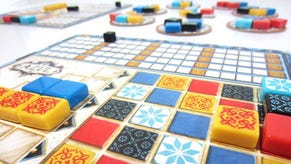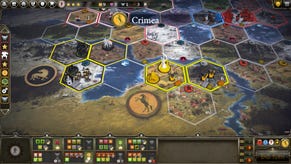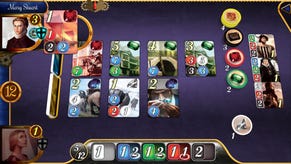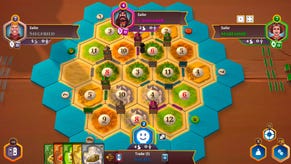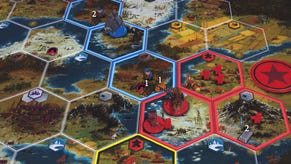How to play Carcassonne: board game’s rules, setup and scoring explained
A chill and fun mediaeval experience
Despite being regularly amongst most classic board games lists, not everyone knows how to play Carcassonne. Based on the French city of the same name, this game is all about building a mediaeval landscape and populating it.
Created by Klaus-Jürgen Wrede in 2000, Carcassonne invites players to dispute for power in a mediaeval scenario where you win by controlling more pieces of land and important landmarks than the other players. While players can find ways to play strategically, Carcassonne is not a difficult game to learn - making it a good choice when introducing board games to someone who has no prior experience!
How to play Carcassonne
- Player count, game length and overview
- How to set up the game
- Gameplay rules
- Final Scoring and ending the game
Carcassonne has become one of the best family board games because of how easy it is to have fun with it. Besides that, because of Carcassonne’s supplemental rules, replaying the game is always a fresh experience.
But just because it’s a classic doesn’t mean everyone has played it! If you want to learn how to play Carcassonne you’ll find everything you need to know in this article.
Player count, game length and overview
The essentials
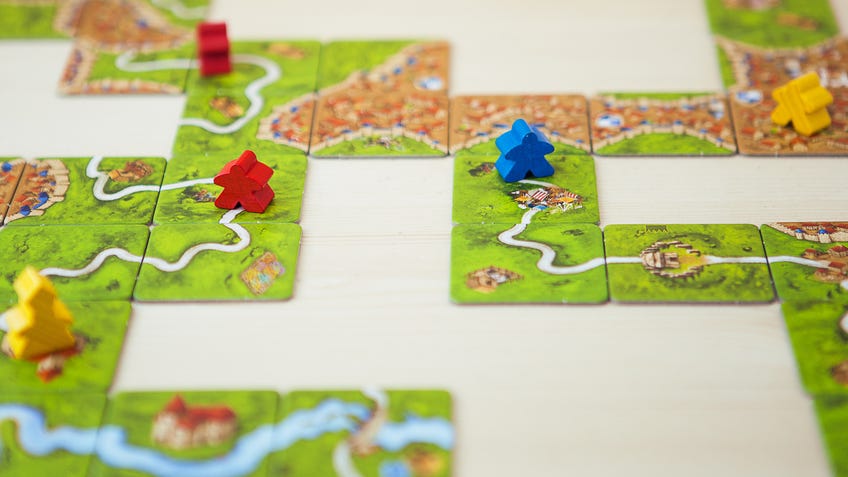
Carcassonne is a board game about developing a civilisation in mediaeval France. Intended for two to five players, this is a quick board game to play: taking around 30 to 45 minutes.
Setup
Layout your game

The setup to Carcassonne is quite simple, making all the preparations easy for newer players to start the game as soon as possible. Even when it comes to adding a few extra pieces the second time you play it, Carcassonne will remain a simple game to set up.
The first time playing Carcassonne, you’re going to use the normal land tiles with a light grey back and the starting tile, which has a darker grey back. All the river tiles - which also have dark grey backs - should go back to the box as indicated by the official rules. At the same time, only the regular meeples are going to be used. The five abbots are going to be kept in the box as well.
In order to prepare the initial setup, you must go through a few basic steps:
- Shuffle the land tiles and make two stacks. Put them facedown on the table.
- Place the starting tile on the table.
- Give each player all eight meeples of the colour they’ve picked.
- Put the scoreboard next to you and place one meeple of each player on the “0” space. The remaining seven comprise your supply of meeples.
- In case you want to play with the mini-expansion the base game comes with, which requires you to use both the river tiles and abbots in your game, these steps change a little bit. First, you must create a third stack only for the 12 river tiles, with the source tile at the top and the lake tile at the bottom of the pile. Then, you must give each player the abbot token matching the colour they have chosen.
Gameplay Rules
Learn how to play the game

In Carcassonne, the game starts with the youngest player and then follows a clockwise order from there. Each player has a turn that is split into three phases:
- Drawing phase
- Placing phase
- Scoring phase
Drawing phase
During this phase, you’re going to draw a tile from one of the piles and connect it to any of the previously placed tiles. At the beginning of the game, you have to connect the tile you just drew to the starting tile.
You can only connect a tile to another if the one you drew has the same landscape feature as the tile you want to connect it to. In Carcassonne, there are six landscape features, although only the first three need to be used in a game with beginners: road, city, monastery, field, river and garden.
Roads: A road is completed when it’s closed at both ends, which means that there is a city or the road loops onto itself. Meeples placed on roads are called travellers.
City: Some tiles might come with part of a city which you must connect to another tile with a city. You will have a complete city when it’s entirely surrounded by walls. Meeples in cities are called knights and some parts of a city can come with a small shield symbol called coat of arms.
Monastery: A little bit different from the other landscape elements in the game, monasteries always come in the centre of the tile. To place it on the table you must connect it using other features it has, such as a road, city or field. The meeples you put on monastery tiles are monks/nuns. A monastery is considered completed only when it’s fully surrounded by other tiles.
Field: Different from all of the other tiles, fields can not exactly be ‘completed’. The specific rules regarding fields and how they work are going to be explained in the placing and end of the game sections. Basically, all you need to know is that a meeple placed on it is called a farmer.
River: Part of the mini-expansion the base game comes with, the river is a special type of tile. Besides having to start with the source title and be completed with the lake tile, every time a river tile has a bend, it must be placed in the opposite direction to the previous river bend.
Garden: Although gardens are not proper tiles, they are present in some tiles of the other types. A garden is a special landscape feature where only abbots can be placed and you will only take it into consideration when playing with the supplemental rules.
What happens if you can’t connect the tile you drew with any already on the table? In the rules, it’s suggested that you put that piece away and draw another one. But, if this isn’t the case and you placed your piece, it’s time for the second phase.

Placing phase
Now you have the piece you just drew on the table, you have the option to place a meeple on it. Keep in mind that you can only do so on the tile you just placed.
This is an important phase since it might determine how many victory points you earn this turn. There are, however, some important rules you must follow when placing a meeple:
- Regardless of the number of landscape elements the tile has, a meeple can occupy only one of them.
- Only one meeple can be placed per landscape feature. If the tile you just placed completed a city where another player already had a meeple, you can’t put another one there. There will be, however, situations in which more than one meeple is in the same feature because different players have placed their meeples on tiles which ended up connected later in the game. In other words, it’s okay if, for example, you and a friend had one meeple in parts of a road that were not connected, but later in the game, a new tile is placed connecting them. This situation changes the scoring for this specific feature though.
- Travellers, knights and monks/nuns are placed standing, while the farmer is placed laid down.
- In case you’re playing using the abbot, you must know that this special meeple can only be placed on monastery or garden tiles.
Scoring phase
This is the last phase of your turn and the moment when you count the points you made with meeples in this turn.
The scoring system in Carcassonne is based on the meeples you have placed on a completed landscape feature. If you got to this phase with, for example, a meeple on a city that is completely surrounded by a wall or on a road that is closed on both ends, you’re going to earn points. The quantity of points you make depends on the type of feature you’ve placed meeples on:
- A road gives you one point per tile used to complete it.
- A city gives you two points for each tile used to complete it and two additional points for each coat of arms in the city.
- A monastery gives you one point for each tile surrounding the tile, plus the monastery tile as well, which means that you will always score nine points for completing a monastery.
- If there is more than one meeple on one feature, the player who has the most meeples on it earns the points. If players have placed the number of meeples, those players receive the same amount of points.
- If you’re playing using the additional rules and placing meeples on fields, you won’t count them now as farmers are only scored at the end of the game. On the other hand, abbots work just like regular meeples in this phase. Abbots have a special ability that activates if you have already placed an abbot and - in your current turn - you choose to skip the placing phase: you can return your abbot and score points based on the number of tiles surrounding the monastery or garden it was on.
Now, move your scoreboard meeple to reflect the number of points you’ve earned that round.
If you have scored this turn, you must take the meeple that is on the completed feature and put it back into your supply. But if your meeple is on an uncompleted feature, you must leave it on the table.
With that, your turn is over and it’s time for the next player to draw a tile.
Final scoring and ending the game
The last stage of the game

Once all the tiles have been played, it’s time to start the final scoring and end the game.
The final scoring begins after the last tile has been placed and which they’ll go through their regular scoring phase.
The final score will only count the remaining meeples in incomplete features or farmers.
- A remaining meeple in a road gives you one point for each road tile.
- A remaining meeple in a city gives you one point for each city tile and coat of arms.
- A remaining meeple in a monastery gives you one point for the monastery and one point for each surrounding tile.
- A farmer gives you three points for each completed city that is adjacent to the field the meeple is on.
After the final scoring, the player with the most points is the winner.



